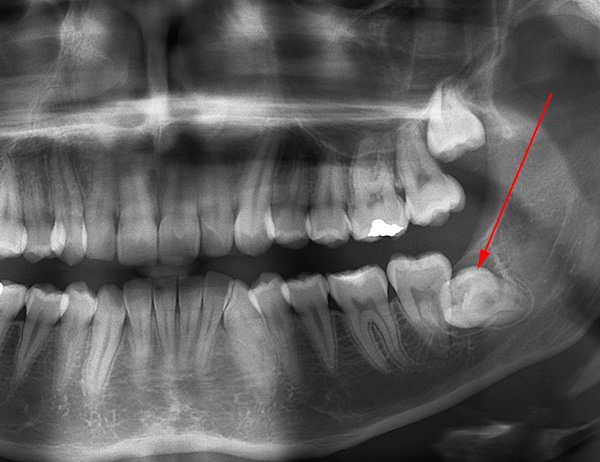
Next you will learn:
- What are retarded teeth and what, in fact, is the essence of the problem with them;
- For what reasons wisdom teeth often cannot erupt normally and how long such a situation can last;
- Whether the retined tooth should be removed, or perhaps it is better to keep it and the problem somehow “resolves” by itself;
- The characteristic symptoms that are usually observed with retention of the tooth;
- How retinirovannye wisdom teeth are removed - the sequence of actions of a dentist-surgeon;
- What can you expect after the operation (including in those cases when the removal was difficult);
- And finally, what should be done if suddenly serious complications arise ...
A general idea of what a retined tooth is can be obtained if we take into account that the word "retention" (retentio) in Latin means "deterrence", "delay" or "retention". So, when they talk about a retarded wisdom tooth, it is, above all, about a delay in teething or in violation of the process of teething.
Simply put, a retined wisdom tooth is an eighth tooth formed but not pierced through the bone of the jaw or gum.
Below the photo clearly shows that the retarded wisdom tooth is literally hidden in the gum:
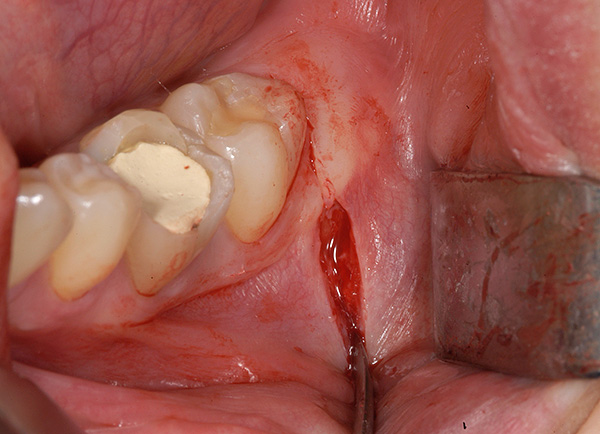
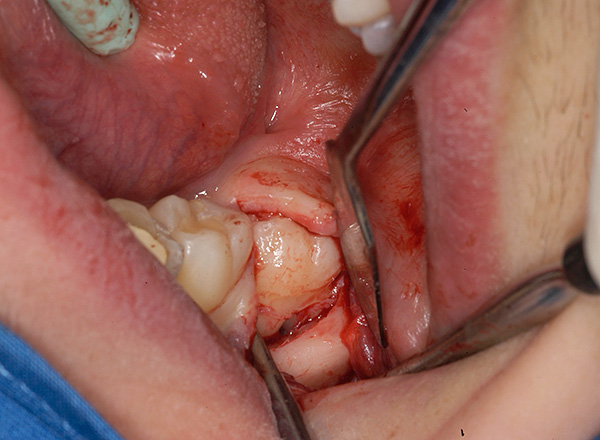
On a note
Not only wisdom teeth can be retinized. For example, “upper fangs” and “lower premolars” (small molars) can “sit” in the bones or in the gums. But still, it is the eighth teeth that most often turn out to be retined.
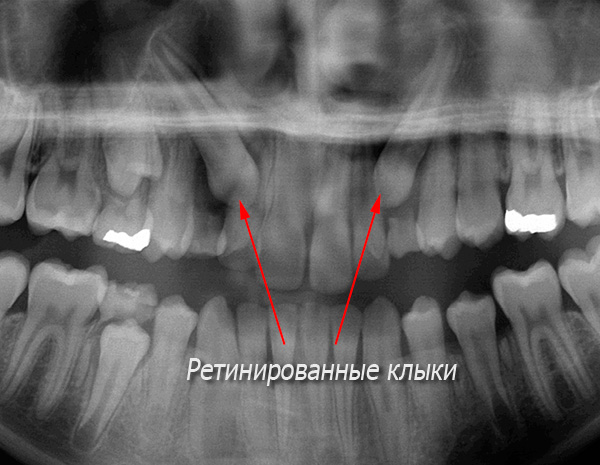
Here it is required to clarify some nuances. In particular, can such retention be called an eruption anomaly? If we talk about wisdom teeth, then their non-eruption up to 25 years in the absence of corresponding problems in general cannot be considered an anomaly. Later - formally it is already possible, since eights after 25 years are normal (for most people) erupt.
Can retention be the partial eruption of the eighth tooth? When a wisdom tooth emerges from under the gum with one or two tubercles, then it is believed that this is not a retined tooth, but a semi-refined one. Such a semi-prosthesis has its own characteristics and sometimes brings much more trouble than the retention itself - we will talk about this a little later.
If the tooth is retined, this does not mean that it must be removed. For example, there are many examples when the eighth tooth “sleeping” for years suddenly became active and literally in a matter of months safely occupied its rightful place in the dentition.
However, quite often, refined teeth still pose serious problems, which can adversely affect not only the dentition, but also throughout the body ...
Why a wisdom tooth cannot cut through and how long it takes
Sometimes a wisdom tooth cannot cut through for more than a year, causing considerable discomfort, while there are cases of completely painless and quick cutting. Experts still argue about why wisdom teeth in some cases cannot erupt normally.
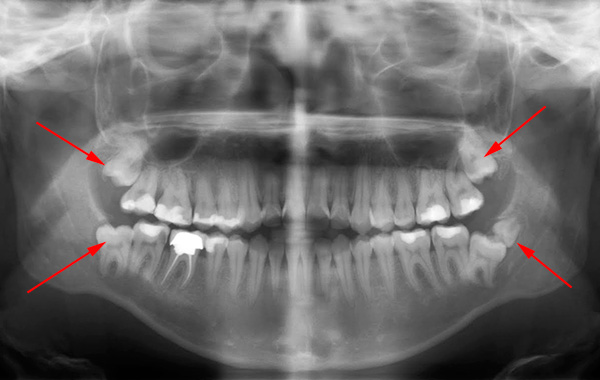
On a note
Wisdom teeth are considered to be rudimentary formations (for example, like the tailbone, which is the rudiment of the tail). According to the theory, when a primitive man ate rough food, without proper heat treatment, this required significant chewing efforts from the jaws and teeth. The last teeth (wisdom) unloaded the end of the jaw, significantly improving the situation regarding chewing effectiveness.
Today, people don’t need to gnaw bones and eat raw meat from a just killed animal, therefore evolution is believed to do its job: if wisdom teeth are almost no longer needed for chewing, then why leave them a place in the jaw? The evolutionary point of view indicates that over the past long period of time, the jaw of a person has narrowed significantly, has become more compact and not so spacious, which creates its own difficulties when trying to cut through eights.
Among the reasons predisposing to tooth retention include the following:
- early loss or removal of primary teeth;
- genetic (hereditary) factor;
- supercomplete teeth;
- poor child nutrition;
- rickets and some infectious diseases.
... And others. In some cases, these factors may well turn a normal tooth germ into a retined tooth.
Normally, the timing of the onset of teething wisdom is 14-25 years. Of course, eights can "climb" a little earlier, and much later, but the most important thing is that this process proceeds comfortably. If a wisdom tooth in an adult for a long time continues to exist in the bone, under the gum, then it will not hurt to check its condition (on an X-ray you can see how it is located in the jaw and whether problems should be expected in the future).
The following is an example of a horizontal wisdom tooth in the jaw:
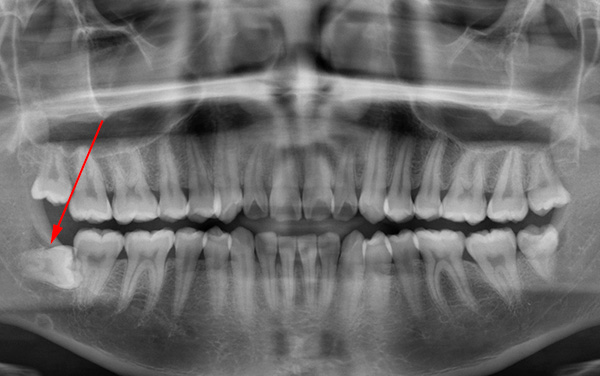
It should be borne in mind that some people may not have the rudiments of the upper and (or) lower wisdom teeth (according to some reports, this is typical for more than 10% of the world's inhabitants). Accordingly, in this case, the eights will never erupt and will not bother throughout life.
Feedback from a dental surgeon:
“Personally, I do not have the rudiments of the 2 upper wisdom teeth, but already at the age of 18, the two lower eighths erupted fully. The absence of upper wise teeth was discovered by chance, after computed tomography associated with ENT disease. It was possible to examine the picture in detail. Almost immediately, it became clear that there were no primordia of the upper teeth of wisdom, which means that you should never wait for their appearance on the surface.
Svyatoslav, Samara
When the rudiment of a wisdom tooth is nevertheless present, the quite logical question arises: will the 7th not interfere with the normal eruption of the eighth? Such fears are not unfounded, since it is the seven most often that prevents the appearance of the wisdom tooth, creating the prerequisites for its retention.
Let's look further at what to do with the retinated wisdom tooth - whether to remove it right away, or can you somehow help it cut through, despite the interfering seven and other difficult factors? ..
Should a retined tooth be removed or is it better to keep it?
It is understandable that few people will want to remove a tooth, even if it cannot cut through and because of it the gum and jaw are constantly sore. And it would be nice if the problem over time somehow “resolved” by itself.
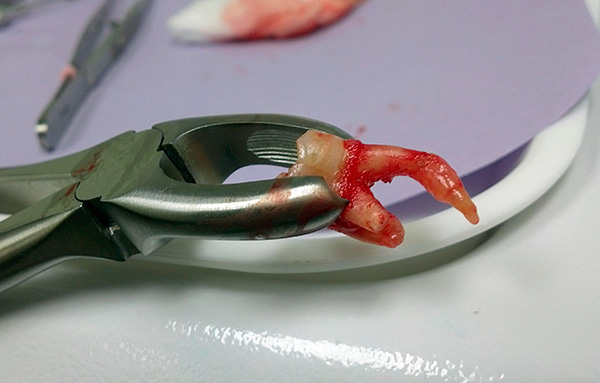
Is this possible, and is it possible to do nothing at all with problems with a retined tooth without harming one's health?
Well, there is no universal answer here: in each case, the decision on the need for tooth extraction must be taken individually.
In the simplest case - in the absence of complaints in a person, as well as with the correct location of the wisdom tooth in the jaw (according to the picture) - it makes no sense to remove it. If a wisdom tooth erupts for a long time (does not appear from the gum), then this is his “right”, and it is almost impossible to accelerate this process.
Now let's see in which cases a retarded tooth will still have to be removed with a high probability. We will analyze situations related only to the retention of the wisdom tooth, without touching the semi-prosthetics for now.
So, to date, the removal of retarded wisdom teeth is recommended for:
- Persistent pain;
- Pronounced inflammatory phenomena;
- The location of the tooth in the follicular cyst;
- Inability to carry out high-quality orthodontic treatment;
- Incorrect position of the tooth in relation to the jaw and (or) adjacent tooth (strong inclination towards the 7th tooth, position partially below it, the wisdom tooth spread, upside down position, etc.).
It is important to note that a recommendation does not imply a mandatory action.
In practice, the situation is usually such that in most cases, the retined tooth will have to be removed with a follicular cyst, serious location anomalies, purulent inflammatory processes (periostitis, abscess, phlegmon, osteomyelitis, odontogenic sinusitis, lymphadenitis) and when the bite is corrected. However, the last word is always for the dentist, since it is he who is responsible, as a doctor, for the life and health of each patient.
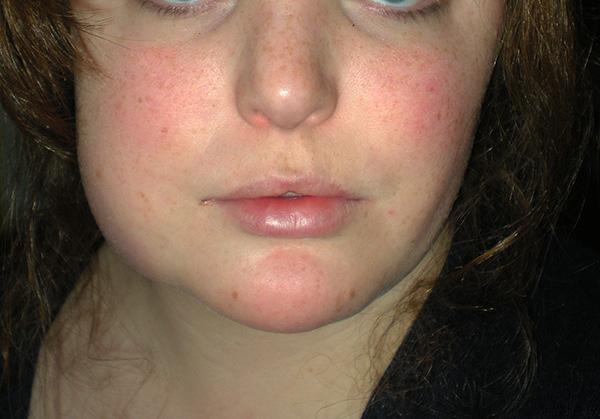
Feedback from a dental surgeon:
“A large group of maxillofacial surgeons are against experiments with the sea waiting for weather: it’s better to remove it before any of the retined teeth ruins the holiday.” In general, these guys know what they are talking about: he saw such unfortunate people at his reception, and even operated on one of them at 55. I ventured to take emergency care, but something did not grow together: for 3 hours of work, the roots did not give in either after they were separated with a drill or with a set of elevators. As a result, he was sent to the city, and there, instead of cutting out the roots, the patient was hollowed out with a chisel for about an hour, a professor at the Department of Maxillofacial Surgery with students.
But the reason for the arrival of this complex patient (my good friend) is that the inflammatory process in the gums near the projection of the wisdom tooth has begun, although all the teeth on this side have long been removed. That’s all, but not all: the lower left wisdom tooth didn’t erupt until the age of 55, and it wouldn’t have appeared itself - it’s just that this eighth, lying horizontally in the jaw, decided to arrange for the patient “kuz'kin mother” to retire. It turned out something like pericoronitis, but there was purulent edema in the gum with the appearance of a fistula, through which pus was evacuated when pressed. If there was no outflow of pus, then, perhaps, life would have been saved to him much earlier. It goes without saying that he left the operation for about a month. That is, approximately 4 weeks after the operation, he began to talk normally with the professor, open his mouth and eat, but this is not because the professor and I tried so hard: I just really got a complicated, retined tooth that was involved in a purulent inflammatory process. ”
Symptoms of Difficult Wisdom Teething
Retained wisdom teeth can remain in the jaw for a very long time completely asymptomatic. In the future, it all depends on the criteria described above: if a tooth does not encounter any obstacles in its path, then it safely takes a normal place at the end of the dentition.
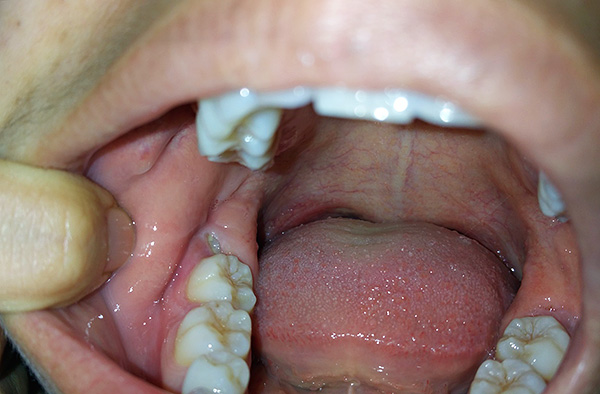
On a note
Normally, in the absence of complicating factors, the wisdom tooth is cut out within 2-3 months, and in severe cases, the process may well drag on for 1-2 years. Moreover, if something interferes with the eight, it can suspend its “move”: it is no coincidence that many patient reviews say that their wisdom tooth erupted as if in several stages.
Often, long before the figure eight appears on the surface, unpleasant symptoms can occur that make a person think about the possible removal of a retarded tooth.
For example, when the nerve fibers are close to the wisdom tooth located in the thickness of the jaw bone, they can be squeezed, which provokes neuritis or neuralgia - severe pains that often radiate along the branches of the trigeminal nerve.
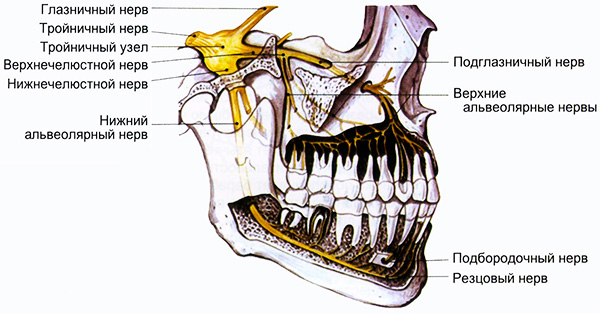
In addition, retention of the tooth can cause the appearance of follicular cysts around it, which, increasing in size from year to year, can become a source of serious complications (osteomyelitis, phlegmon, etc.). In acute forms, the body temperature rises to high values, and the condition of the patient as a whole can be very serious.
Often, against the background of the inflammatory process, severe edema is observed in the area of the retined tooth.Violation of facial symmetry, coupled with pain and high fever, make it very clear that something serious is happening that requires urgent intervention by a specialist doctor.
Now let's assume that the eighth tooth has crossed the bone barrier, and part of its crown has already come out of the gums. At first glance, it may seem that the most difficult is behind - the tooth almost cut through, only a little remains. However, in reality, things may not be so rosy.
The following photo shows an example of a semi-reinforced wisdom tooth:
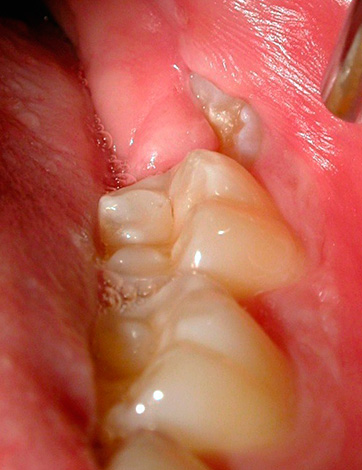
Often under the gingival hood particles of food and bacteria accumulate, an inflammatory process occurs - pericoronitis. When a purulent exudate forms under the gum, symptoms appear that impede a person’s normal life: swelling in the area of the wisdom tooth, poor general condition, fever up to 38-39 ° C, inability to chew and even open your mouth normally, severe pain, often throbbing and radiating to various sections of the face.
With such symptoms, it is entirely possible to understand a person’s desire to immediately remove a semi-dentured tooth and not suffer further. However, in such a situation, there is still a way to help the wisdom tooth to erupt without resorting to at least removal. It is about excising the gingival hood.
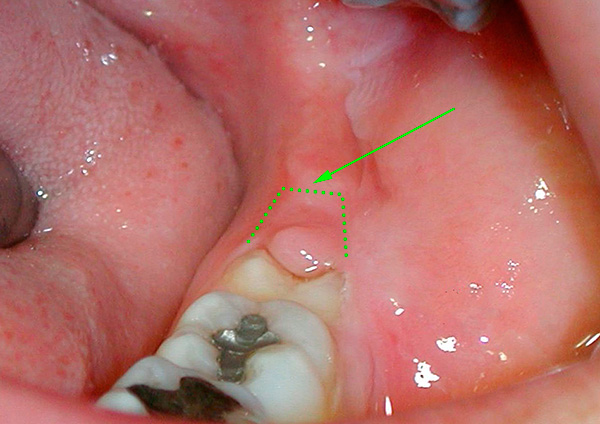
On a note
There are still many supporters of the method of excising the hood over the wisdom tooth, which partially cut through. This procedure is most often performed much faster than the removal operation: anesthesia is done, an overgrown gum is excised with a scalpel, a hemostatic swab is placed - about 10 minutes for the entire procedure.
However, it also happens that this method, especially if it is impossible for the wisdom tooth to take its place in the row even after excising the hood, provokes the risks of further complications. Sometimes you have to excise the hood repeatedly. That is why opponents of this method offer to immediately remove the wisdom teeth with difficult teething.
How retarded wisdom teeth are removed and how long it can take.
If the extraction of the retined tooth is inevitable (swollen cheek, severe pain, orthodontic treatment), then the dentist-surgeon takes up the matter.
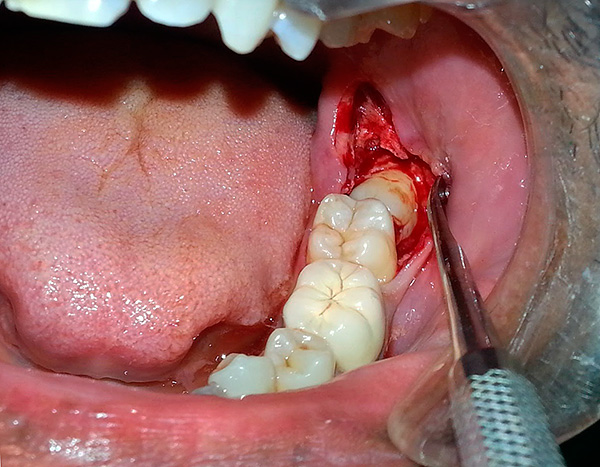
Let's see how all this usually happens in practice and, in particular, answer the following burning questions:
- Will I have to endure severe pain?
- How long does a complicated removal usually take?
- Will they cut the gum and cut the bone?
- Will they be sutured, or can we do without them?
Let's start with anesthesia. Most often, the removal of a retined and half-tooth is carried out under local anesthesia, that is, a person is completely conscious, but the area of surgical intervention does not feel or almost does not feel.
It should be borne in mind that some people "freeze takes" without problems, and someone has to one degree or another to experience for themselves what ineffective anesthesia is. And no matter how the dental clinics praised in advertising that all the procedures for removing teeth are performed absolutely without pain, however, we will say frankly - painless removal is the result of many factors, among which the following play a leading role:
- The professionalism of the doctor;
- Anesthetic quality;
- The condition of the patient.
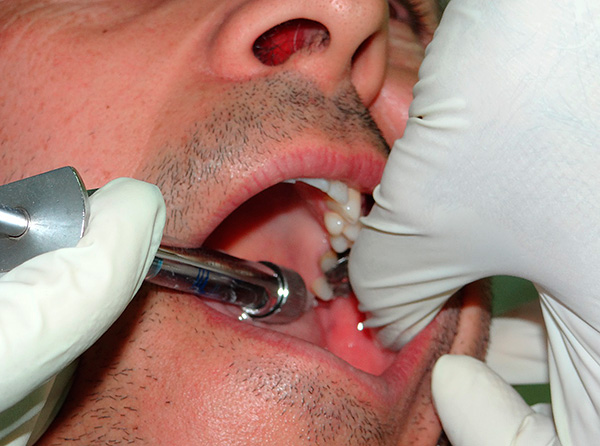
If the dentist is experienced enough, organized his work correctly and followed the anesthesia technique, then in almost 95% of cases the success of pain relief is guaranteed. Knowing the properties of anesthetics and knowing how to work with them, it is even possible to carry out high-quality anesthesia with an inexpensive domestic drug (another question is that this may be associated with additional time and an increased risk of adverse reactions, while the choice of imported anesthesia suitable for a given clinical case usually speeds up the onset of persistent "freezing").
The patient’s condition plays an equally important role: for example, the presence of alcohol in the blood and a strong fear can seriously worsen the conditions of anesthesia - this should be known to everyone who is going to go for a tooth extraction (not just a retined one).
Removing ("pulling") the retarded wisdom tooth can take an average of 10-15 minutes to 2-3 hours.
It's important to know
Today you can find advertising with a focus on the very quick removal of uncracked or half-erupted wisdom teeth: they say, literally in a matter of minutes your problem will be solved.
So, it should be borne in mind that professional maxillofacial surgeons will never say in advance for sure that the removal of a retarded wisdom tooth will be simple and quick.
As for the process of removing the retired eight, it usually consists of the following steps:
- Preliminary preparation (patient instruction, removal of dental plaque, antiseptic treatment of the gums, etc.);
- Local anesthesia (although in some clinics they may offer general, that is, anesthesia);
- Creating access to the retined tooth (incision of the gum with a scalpel, removal of bone tissue with cutters with cooling. In some clinics they can use a laser scalpel);
- Extraction of a wisdom tooth by elevators, or sawing it with burs into parts and phasing out each piece. Do not be afraid of cutting a tooth out of the jaw, as it almost always speeds up work 2-3 times and allows you to come to a positive result in less time. Compared to sawing, it is much more unpleasant to hollow out a retined tooth with a chisel;
- Hemostasis (bleeding stop). After removal, preparations based on artificial bone (wound plastic), a hemostatic sponge or turunda with anti-inflammatory, analgesic and antiseptic agents can be placed in the hole after removal.
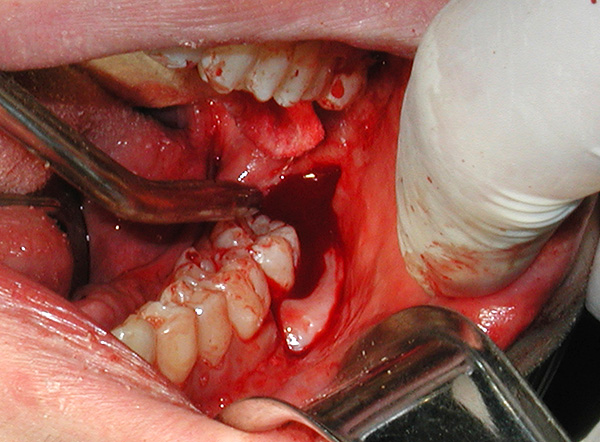
Sometimes, for the wound to heal safely, stitches are sutured after the removal of the retarded wisdom tooth. In most cases, sutures play a positive therapeutic role, reducing the lumen of the wound and creating a barrier to the penetration of food and infection into the well.
On a note
Self-absorbable sutures are a more expensive pleasure compared to conventional ones, but there is no need to re-contact the dentist about removing them.
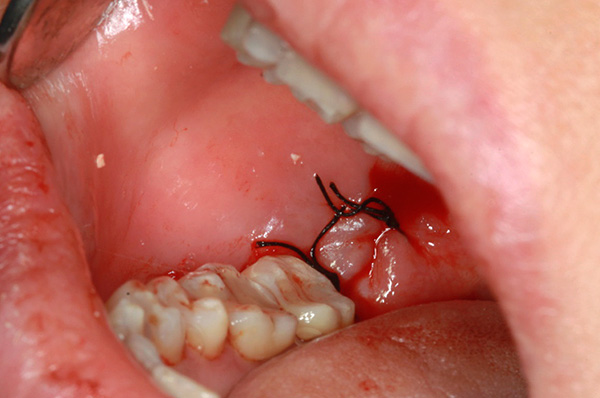
As for bleeding during and after tooth extraction, it is usually mild and passes quickly. The fact is that adrenaline is specially added to modern anesthetics, which tends to narrow the blood vessels, after which it is convenient for the dental surgeon to carry out even complex removal of the retined tooth, since there is very little blood lost.
What awaits you after surgery, especially if tooth extraction was difficult
A professional doctor, after removing any tooth (not just a retined one), provides the patient with a memo (most often written) so that all the necessary recommendations after the operation are fulfilled.
Usually, the dentist emphasizes that after removal, the following are possible:
- Pain
- Edema;
- Increase in temperature (a protective reaction of the body);
- Chewing disorder;
- Difficult mouth opening
- Slight bleeding from the hole;
- Temporary disability.
Here is an example of such a reminder:
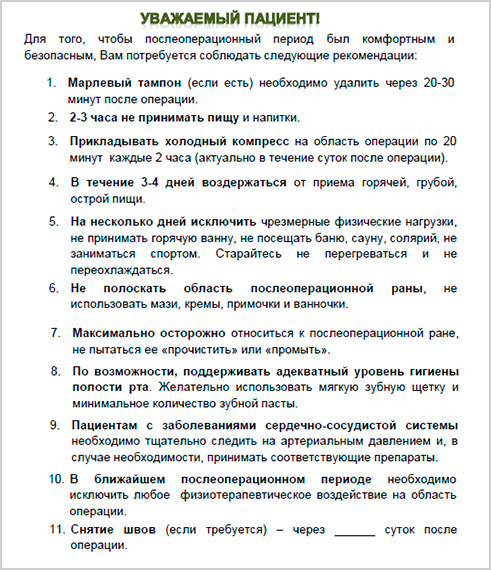
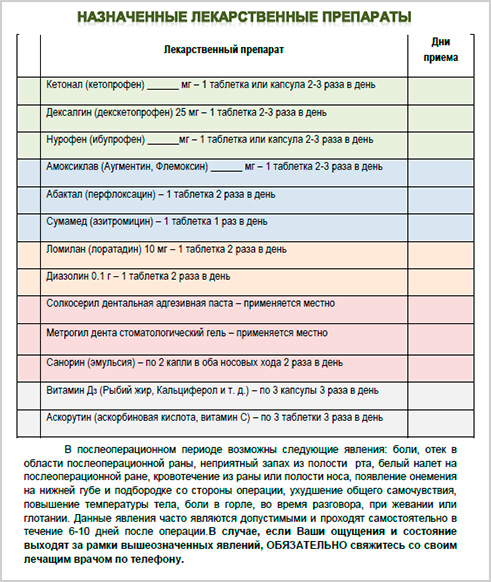
That is why the instruction for the patient includes a list of actions and drugs that prevent complications. For example, so that there is no postoperative edema, you should apply a cold compress according to a special scheme during the day after removal. To eliminate the risks of infectious complications, the doctor may prescribe antibiotics.
To create a certain level of wound hygiene, special sprays, gels and ointments for topical application can be used.
The possibility of taking painkillers is obvious: in order not to suffer from severe pain for 1-3 days after surgery, analgesics may be required.
Question 1. What should I do if a huge bruise appears on my face after the removal of the retarded wisdom tooth?
The appearance of a hematoma on the skin in the area of the removed wisdom tooth is a rare, but natural phenomenon. Most often it happens in patients who suffer from arterial hypertension. Post-traumatic edema turns into a “bruise”, which, without additional intervention, turns yellow and disappears without a trace.
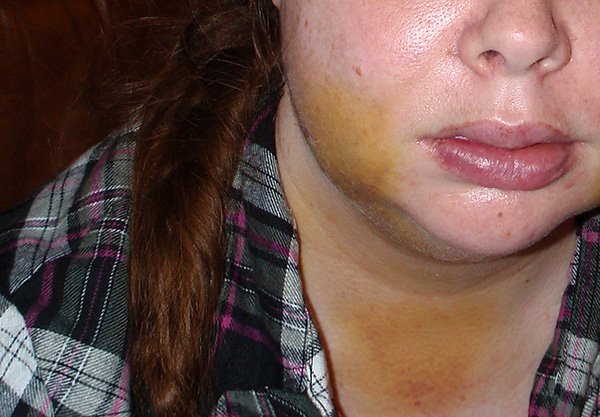
Question 2. Why did the numbness of the lip and chin occur after surgery to remove the lower wisdom tooth?
Since the retined tooth is often located close to the mandibular nerve passing in the thickness of the lower jaw, temporary numbness (paresthesia) may occur after its removal, which is most often associated with compression of nerve fibers, and less often with damage to them. Sensitivity recovery may take from several weeks to several months. Physiotherapy prescribed by a doctor can speed up the process.
Patient review:
“6 days ago I removed the retired eight from the bottom. A female surgeon with extensive experience removed. Anesthesia was normal, lasted a long time. The eight had crooked roots, so it had to be cut. I already deleted the eight, but on top. As usual, there was a slight swelling of the cheeks. Until the night she waited for the frost to go away, tired, fell asleep without hind legs. The next morning, the left side of the chin, half of the lip, the tip of the tongue and gum near 5 teeth remained frozen. Numbness is felt like goosebumps and tingling sensations. I don’t know what to do now ... "
Oksana, Moscow
If, after local anesthesia, the patient is most often released from the office 10-30 minutes after the operation, then after anesthesia you still have to “rest”. In general, today, the removal of a retarded wisdom tooth under anesthesia is a common phenomenon. The fact is that the dentist himself assesses the complexity of the upcoming manipulation and, according to the indications (or at the request of the patient, if it is not associated with possible health risks), carries out the removal under anesthesia.
If stitches (not self-absorbable) were applied, then they will need to be removed later. Before 6-8 days, they are usually not removed. Removing sutures is almost always painless: local anesthesia is enough.
As for the speed of wound healing - this is an individual characteristic. Primary epithelization proceeds in a period of 1 to 3 weeks, and the gum completely heals (smoothed) most often in 5-6 months.
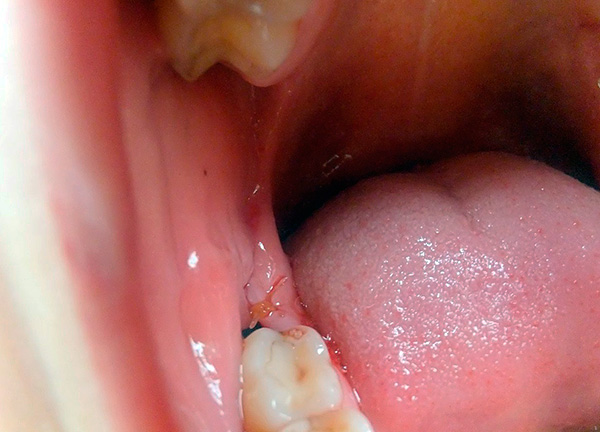
Removing a retined wisdom tooth may fall into the category that gives a person the right to “lie down” at home, that is, get a sick leave. The timing is determined not only by the operating doctor - often the dentist is also connected to this matter at the place of residence.
Comment of a practicing dental surgeon:
“After the removal of the retarded wisdom tooth from the kindergarten teacher, she spent a couple of days in the hospital of maxillofacial surgery with the issue of a sick leave for only 6 days. And I extended it by another 8: I will explain why. Since opening the mouth was still difficult after removing the sutures, it was necessary to extend, although in general, the quality of life did not suffer much. It’s just that it would be impossible to control children with such speech impairments and impaired mouth opening.
What to do if complications arise
Unfortunately, various kinds of complications after the extraction of retined teeth are not so rare, and not all patients know what to do in a given situation.
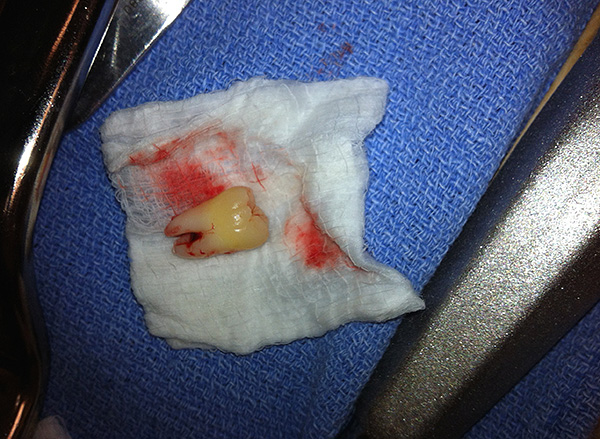
If we analyze the reviews of patients, then most often the following 3 points are of greatest interest:
- What to do with prolonged pain?
- Why does an unpleasant smell appear from the hole and how to get rid of it?
- Will the sharp edges of the hole dissolve by themselves?
- And finally, what should I do if it is impossible to open my mouth normally after tooth extraction?
To begin with, at home, in terms of treatment, you can only do what the doctor prescribed. If problems arise, and the doctor practically did not prescribe anything, then you should run to the dentist for a consultation, or for professional help.
In the appointments of the dentist after the removal of any tooth, especially the one that has been retarded, an analgesic appears - an anesthetic. However, some patients believe that taking 3-5 tablets in 1 hour is normal, and not suspecting that this can lead to much more serious consequences than pain after tooth extraction.

If severe pain continues and painkillers do not help within the prescribed course and in regulated doses, then you do not need to increase the dosage at times, but you need to run to the doctor for help.
As for the hole, from which it can smell unpleasant, then, as a rule, the problem is solved by a simple improvement in oral hygiene:
- Accurate brushing with a soft toothbrush (many people neglect this procedure for the period of wound healing);
- Oral baths with antiseptic solutions (but not active rinses, so as not to wash the blood clot from the hole!)
If there is an unpleasant odor, but there is no pain, discharge of pus and fever, then we can say by 95% that the wound heals in general normally. If the unpleasant odor is accompanied by characteristic signs of inflammation, then these symptoms are closer to the alveolitis, which is treated by the dentist with the help of a curettage of the hole under local anesthesia and the application (as appropriate) of anti-inflammatory gels or ointments.
After not very carefully performed removal of the retained tooth, the sharp edges of the alveoli bone can be felt in the hole, which is important to remove in time, that is, smooth the edges to avoid gum injury with these “spikes”. Do not rely on the fact that they quickly close the gums or resolve by themselves. This procedure is also performed by a dental surgeon.
Well, in conclusion, it is worth noting that sometimes after removing a wisdom tooth for several days it can be difficult to fully open your mouth - this is a normal option, since the tissues involved in opening the mouth are often involved in the area of inflammation and swelling. Rest is necessary for comfortable healing, which ultimately leads to normal opening of the mouth - most often within 2 to 3 weeks after complex removal.
Be healthy!
An interesting video with an example of removing the lower retinirovannogo wisdom tooth with preliminary sawing it into parts
“Salvation” of the retined fang using the braces

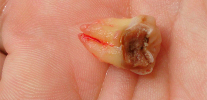

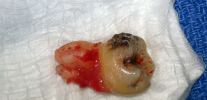
Very detailed and sensible description. Thanks.